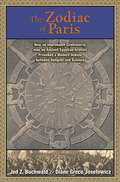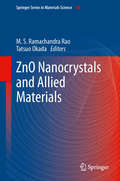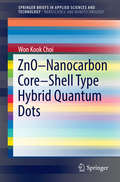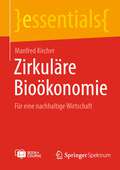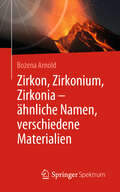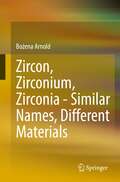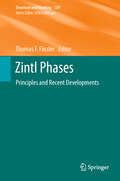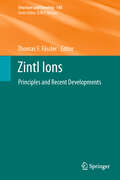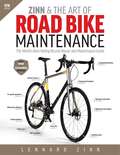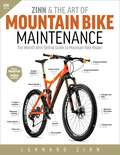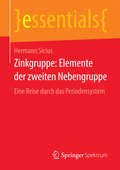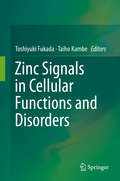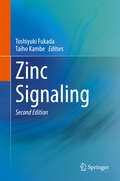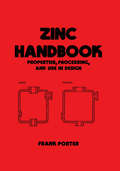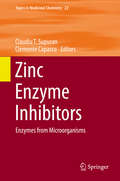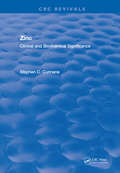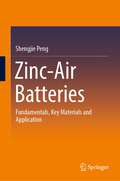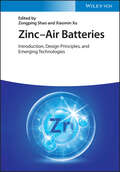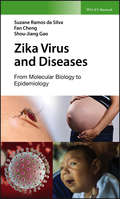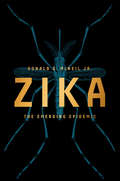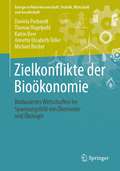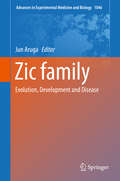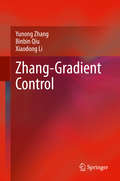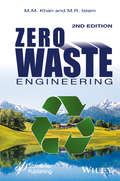- Table View
- List View
The Zodiac of Paris: How an Improbable Controversy over an Ancient Egyptian Artifact Provoked a Modern Debate between Religion and Science
by Jed Z. Buchwald Diane Greco JosefowiczThe clash of faith and science in Napoleonic FranceThe Dendera zodiac—an ancient bas-relief temple ceiling adorned with mysterious symbols of the stars and planets—was first discovered by the French during Napoleon's campaign in Egypt, and quickly provoked a controversy between scientists and theologians. Brought to Paris in 1821 and ultimately installed in the Louvre, where it can still be seen today, the zodiac appeared to depict the nighttime sky from a time predating the Biblical creation, and therefore cast doubt on religious truth. The Zodiac of Paris tells the story of this incredible archeological find and its unlikely role in the fierce disputes over science and faith in Napoleonic and Restoration France.The book unfolds against the turbulence of the French Revolution, Napoleon's breathtaking rise and fall, and the restoration of the Bourbons to the throne. Drawing on newspapers, journals, diaries, pamphlets, and other documentary evidence, Jed Buchwald and Diane Greco Josefowicz show how scientists and intellectuals seized upon the zodiac to discredit Christianity, and how this drew furious responses from conservatives and sparked debates about the merits of scientific calculation as a source of knowledge about the past. The ideological battles would rage until the thoroughly antireligious Jean-François Champollion unlocked the secrets of Egyptian hieroglyphs—and of the zodiac itself. Champollion would prove the religious reactionaries right, but for all the wrong reasons.The Zodiac of Paris brings Napoleonic and Restoration France vividly to life, revealing the lengths to which scientists, intellectuals, theologians, and conservatives went to use the ancient past for modern purposes.
ZnO Nanocrystals and Allied Materials
by M S Ramachandra Rao Tatsuo OkadaZnO has been the central theme of research in the past decade due to its various applications in band gap engineering, and textile and biomedical industries. In nanostructured form, it offers ample opportunities to realize tunable optical and optoelectronic properties and it was also termed as a potential material to realize room temperature ferromagnetism. This book presents 17 high-quality contributory chapters on ZnO related systems written by experts in this field. These chapters will help researchers to understand and explore the varied physical properties to envisage device applications of ZnO in thin film, heterostructure and nanostructure forms.
ZnO-Nanocarbon Core-Shell Type Hybrid Quantum Dots
by Won Kook ChoiThis book offers a comprehensive overview of ZnO-nano carbon core shell hybrid issues. There is significant interest in metal oxide/nanocarbon hybrid functional materials in the field of energy conversion and storage as electrode materials for supercapacitors, Li ion secondary battery, electrocatalysts for water splitting, and optoelectronic devices such as light emitting diodes and solar photovoltaic cells. Despite efforts to manipulate more uniform metal oxide-nanocarbon nanocomposite structures, they have shown poor performance because they are randomly scattered and non-uniformly attached to the nanocarbon surface. For higher and more effective performance of the hybrid structure, 3D conformal coating on metal oxides are highly desirable. In the first part of the book, the physical and chemical properties of ZnO and nanocarbons and the state-of-the-art in related research are briefly summarized. In the next part, the 3D conformal coating synthetic processes of ZnO templated nanocarbon hybrid materials such as ZnO-graphene,-C60, single-walled (SWCNT) are introduced with the aid of schematic illustrations. Analysis of their chemical bonding and structure are also presented. In the final section, several applications are presented: UV photovoltaic cells and photoelectrochemical anodes for water splitting using ZnO-C60 and ZnO-graphene, white-light-emitting diodes based on ZnO-graphene quantum dots(GQDs), inverted solar cells using ligand-modified ZnO-graphene QDs, and P(VDF-TrFE) copolymer with mixed with nano-ring SWCNT. The book describes how strong anchoring bonds between a ZnO core and carbon nanomaterial shell will ultimately prevail over the main drawbacks of ZnO with high charge recombination and poor electrochemical stability in liquid solutions. Due to the moderate energy states and excellent electric properties of the nanocarbons, ultrafast charge carrier transport from the ZnO core to the nanocarbon shell is guaranteed with the use of the photoluminescence (PL) lifetime measurement. Given the growing interest and significance of future research in optoelectronic and electrochemical devices applications, the contents are very timely. This book is targeted towards researchers looking for highly efficient metal oxide-nanocarbon hybrid functional materials in the fields of nano-optoelectronics, photoelectrochemistry, energy storage and conversion.
Zirkuläre Bioökonomie: Für eine nachhaltige Wirtschaft (essentials)
by Manfred KircherFür Lebensmittel, Kleidung, Medizin, Papier, Chemieprodukte sind und bleiben wir auf kohlenstoffhaltige Rohstoffe angewiesen. Um fossile Rohstoffe abzulösen, muss die Industrie auf nachhaltige Kohlenstoffquellen umsteigen. Infrage kommt Biomasse aus der Land- und Forstwirtschaft, die aber selbst begrenzt ist. Das Konzept der zirkulären Bioökonomie sieht deshalb die verstärkte Nutzung von Reststoffen, Bio-Abfällen und CO2 vor. Um die Umstellung der Wirtschaft bis zum Jahr 2045 zu erreichen, müssen Infrastruktur und Rahmenbedingungen zügig angepasst werden.Den kostenlosen Zugang zum Online-Kurs finden Sie direkt im Buch.
Zirkon, Zirkonium, Zirkonia - ähnliche Namen, verschiedene Materialien
by Bożena ArnoldIm vorliegenden Buch finden Sie viele spannende und oft erstaunliche Informationen über diese außergewöhnlichen und vielfältigen Materialien. Die Darstellung ist im Wesentlichen chronologisch aufgebaut und folgt der Geschichte der Entdeckung dieser Materialien. Dabei werden ihre Eigenschaften und Anwendungsbereiche beschrieben. Das Buch stellt eine Mischung aus Fach- und Sachbuch dar: verständlich für Fachleute und Laien.
Zircon, Zirconium, Zirconia - Similar Names, Different Materials
by Bożena ArnoldIn this book you will find a lot of exciting and often astonishing information about these extraordinary and diverse materials. The presentation is essentially structured chronologically and follows the history of the discovery of these materials. Their properties and areas of application are described. The book is a mixture of specialist and non-fiction: understandable for experts and laypeople.This book is a translation of the original German 1st edition Zirkon, Zirkonium, Zirkonia - ähnliche Namen, verschiedene Materialien by Bożena Arnold, published by Springer-Verlag GmbH Germany, part of Springer Nature in 2019. The translation was done with the help of artificial intelligence (machine translation by the service DeepL.com). A subsequent human revision was done primarily in terms of content, so that the book will read stylistically differently from a conventional translation. Springer Nature works continuously to further the development of tools for the production of books and on the related technologies to support the authors.
Zintl Phases
by Thomas F. FässlerGordon J. Miller, Michael W. Schmidt, Fei Wang, Tae-Soo You: Quantitative Advances in the Zintl-Klemm Formalism Jürgen Evers: High Pressure Investigations on AIBIII Zintl Compounds (AI = Li to Cs; BIII = Al to Tl) up to 30 GPa Andrei Shevelkov, Kirill Kovnir: Zintl Clathrates Ulrich Häussermann, Verina F. Kranak, Kati Puhakainen: Hydrogenous Zintl Phases: Interstitial versus Polyanionic Hydrides
Zintl Ions
by Thomas F. FässlerR. Bruce King: Structure and Bonding in Zintl Ions and Related Main Group Element Clusters Stefanie Gärtner, Nikolaus Korber: Polyanions of Group 14 and Group 15 Elements in Alkali and Alkaline Earth Metal Solid State Compounds and Solvate Structures Bryan Eichhorn, Sanem Kocak: Dynamic Properties of the Group 14 Zintl Ions and Their Derivatives Thomas F. Fässler: Relationships between soluble Zintl anions, ligand-stabilized cage compounds, and intermetalloid clusters of tetrel (Si - Pb) and pentel (P - Bi) elements Gerasimos S. Armatas, Mercouri Kanatzidis: Germanium-Based Porous Semiconductors from Molecular Zintl Anions
Zinn & the Art of Road Bike Maintenance: The World's Best-Selling Bicycle Repair and Maintenance Guide
by Lennard ZinnZinn & the Art of Road Bike Maintenance is the world&’s best-selling guide to bicycle repair and maintenance.From basic repairs like how to fix a flat tire to advanced overhauls of drivetrains and brakes, Lennard Zinn&’s clearly illustrated guide makes every bicycle repair and maintenance job easy for everyone. Lennard Zinn is the world&’s leading expert on bike maintenance and repair. His friendly step-by-step guide explains the tools you&’ll need and how to know you&’ve done the job right. The book&’s interior is easy to read, even in a dimly-lit garage or workshop. Hundreds of hand-drawn illustrations and exploded parts diagrams show just the right level of detail to lead you through every bicycle repair task. This smartly organized guide shows how to repair new and old bicycles from top to bottom. In over 500 pages, Zinn&’s guide includes simple instructions for hundreds of bike maintenance and repair jobs: Basics: How to fix a flat tire, lube a bicycle chain, adjust the brakes Emergency repairs: How to fix a broken chain, tighten loose spokes, repair a bent derailleur Easy shifting: How to adjust shifters, derailleurs, and cables for clean and smooth shifting Wheels: How to true a wheel, install a new tire, change a cassette, replace broken spokes, build your own wheels Overhauls: How to service and replace pedals, chains and chainrings, saddles, handlebars, stems, headsets, forks, bottom brackets New tech: How to maintain 11-speed systems, electronic and wireless shifters, disc brakes Cyclocross: How to set up a &’cross bike for racing, select the right components, and make quick repairs Troubleshooting: How to figure out what&’s wrong with any bike and fix it Zinn & the Art of Road Bike Maintenance makes bicycle repair and maintenance easy, quick, affordable, and fun. With Zinn at your side, you&’ll know how to keep your bicycling running smoothly for years. What&’s New in Zinn & the Art of Road Bike Maintenance, 5th Ed.: More than 700 comprehensive illustrations and exploded views. New chapter on electronic shifting covers maintenance, service, repair, and troubleshooting of all Shimano, SRAM, and Campagnolo electronic shifting groups. New chapter on disc brakes covers maintenance, service, and repair of all hydraulic and mechanical systems. New tech covered in depth: through-axle forks, SRAM eTap wireless shifting, second generation Shimano and Campagnolo electronic shifting, direct-mount sidepull brakes, SRAM X-Sync 1x11 cyclocross systems, tubular tire gluing tapes. New troubleshooting charts New master guide to press-fit bottom brackets Also covered in the 5th edition: All derailleur shifting systems (5-speed through 11-speed); all bottom bracket systems (cone-and-cup through press-fit); all brake systems (including caliper, V-brake, cantilever, and disc); all headset, stem, handlebar and fork systems; wheelbuilding for all bikes including cyclocross and disc-brake wheels; special sections on cyclocross throughout including troubleshooting, maintenance, service, repair, and equipment selection; updated and expanded torque tables; complete illustration index and complete subject index.
Zinn & the Art of Mountain Bike Maintenance: The World's Best-Selling Guide to Mountain Bike Repair
by Lennard ZinnZinn & the Art of Mountain Bike Maintenance is the world&’s best-selling guide to the maintenance and repair of mountain bikes, hybrids, and fat bikes.From basic repairs like how to fix a flat to advanced overhauls of drivetrains and brakes, Lennard Zinn&’s clearly illustrated guide makes every bike repair and maintenance job easy for everyone. Lennard Zinn is the world&’s leading expert on bike maintenance and repair. His friendly, step-by-step guide explains the tools and parts you&’ll need and how to know you&’ve done the job right. The book&’s interior is easy to read, even in a dimly-lit garage or workshop. Hundreds of hand-drawn illustrations and exploded-parts diagrams show just the right level of detail to lead you through every mountain bike repair task. This smartly organized guide shows how to repair new and old mountain bikes from top to bottom. In over 500 pages and more than 750 illustrations, Zinn&’s guide includes simple instructions for hundreds of mountain bike maintenance and repair jobs: Basics: How to fix a flat tire, lube a bicycle chain, adjust the brakes Emergency repairs: How to fix a broken chain, tighten loose spokes, repair a bent derailleur Easy shifting: How to adjust shifters, derailleurs, and cables for clean and smooth shifting Wheels: How to true a wheel, install a new tire, change a cassette, replace broken spokes, build your own wheels Overhauls: How to service and replace pedals, chains and chainrings, saddles, handlebars, stems, headsets, forks, bottom brackets New tech: How to maintain 1x-speed systems, electronic and wireless shifters Troubleshooting: How to figure out what&’s wrong with any bike and fix it Zinn & the Art of Mountain Bike Maintenance makes bicycle repair and maintenance easy, quick, affordable, and fun. With Zinn at your side, you&’ll know how to keep your bicycle running smoothly for years. New in the 6th Edition: A chapter on electronic shifting covers maintenance, service, repair, and troubleshooting of all Shimano electronic shifting groups. Also included: How to program your electronic shifting system for personalized shifting as well as real-time display and shift recording on a head unit. A chapter on disc brakes covers maintenance, service, and repair of all hydraulic and mechanical systems. Includes integrated systems and their bleeding requirements. New guides on how disc brake mounting adapters work and how to install them. Complete info on the new 11-speed and SRAM 12-speed drivetrains. Info on all the newest bottom brackets including 1x11 and 1x12 systems. New guidelines on wheel size selection for your frame size, suspension settings, and travel. New procedures for mounting and sealing tubeless tire systems. New usage guidelines for flat-prevention sealants. Updated guides on replacing press-in bottom brackets with thread-in bottom brackets. New wheel lacing guidelines for building disc-brake compatible wheels. Updated and expanded guides on how to tune, rebuild, and maintain suspension forks and rear shocks. Includes tuning guides for preload, compression, rebound, and sag. Updated and revised troubleshooting tables, torque tables, and gearing charts for 26&”, 27.5&”, and 29&” bikes. Also covered in the 6th edition: All derailleur shifting systems; all bottom bracket systems; all brake systems; all headset, stem, handlebar and fork systems; wheelbuilding for all bikes; updated and expanded torque tables; complete indexes of all illustrations and topics covered. Whether you&’re riding a classic Stumpjumper or a carbon-fiber race machine, Zinn has got you covered!
Zinkgruppe: Eine Reise durch das Periodensystem (essentials)
by Hermann SiciusHermann Sicius stellt ausf#65533;hrlich die Elemente der zweiten Nebengruppe vor (Zink, Cadmium, Quecksilber, Copernicium), deren physikalische und chemische Eigenschaften relativ #65533;hnlich sind. Auswirkungen der Lanthanoidenkontraktion erkennt man hier kaum noch. Cadmium steht in seinen Eigenschaften etwa zwischen dem Zink und dem Quecksilber. Zink und Cadmium haben negative Normalpotentiale, wogegen Quecksilber ein Halbedelmetall ist. Die Elemente dieser Gruppe geben meist ein oder zwei #65533;u#65533;ere Valenzelektronen ab, um eine stabile Elektronenkonfiguration zu erreichen. F#65533;r das h#65533;chste Element dieser Nebengruppe, das Copernicium, konnten bisher kaum chemische Untersuchungen durchgef#65533;hrt werden. Es ist zu erwarten, dass es sich chemisch #65533;hnlich wie Quecksilber verh#65533;lt. Zink als Element kennt man seit dem 17. Jahrhundert, Cadmium seit 1817, wogegen Quecksilber schon in der Antike bekannt war. Die erstmalige Darstellung von Atomen des Coperniciums gelang 1996.
Zinc Signals in Cellular Functions and Disorders
by Toshiyuki Fukada Taiho KambeThis book describes the crucial role of "zinc signals" in biological processes on a molecular and physiological basis, discussing future directions and questions underlying this unique phenomenon. To accomplish this, a group of worldwide leaders in the field, who have made outstanding contributions, overview zinc signals from a professional standpoint. Zinc plays an indispensable role in various cellular processes. It regulates a great number of protein functions including transcription factors, enzymes, adapters, and growth factors as a structural or catalytic factor or both. Recently, another function of zinc has received extensive interest and attention because of its potential importance as a signaling mediator. Zinc plays a dynamic role as an intracellular and extracellular signaling factor and thus regulates cellular signaling pathways, which enables communication between cells, conversion of extracellular stimuli to intracellular signals, and control of various intracellular events. These functions of zinc have become recognized as "zinc signals," which play critical roles in physiology, and therefore their imbalance can cause a variety of problems with regard to human health. Because the notion of zinc signals is quite new and no integrative review books focusing on them have yet been published, we believe this book will provide very timely information on the subject and thus should be of importance and interest to a wide range of readers.
Zinc Signaling
by Toshiyuki Fukada Taiho KambeThis book, now in an extensively revised second edition, describes the crucial role of zinc signaling in biological processes on a molecular and physiological basis. Global leaders in the field review the latest knowledge, including the very significant advances in understanding that have been achieved since publication of the first edition. Detailed information is provided on all the essentials of zinc signaling, covering molecular aspects and the roles of zinc transporters, the zinc sensing receptor, and metallothioneins. Detection techniques for zinc signals, involving genetically encoded and chemical probes, are also described. The critical contributions of the zinc signal in maintaining health and the adverse consequences of any imbalance in the signal are then thoroughly addressed. Here, readers will find up-to-date information on the significance of the zinc signal in a wide range of conditions, including cardiovascular disorders, neurodegenerative diseases, diabetes, autoimmune diseases, inflammatory conditions, skin disease, osteoarthritis, and cancer. The book will be of value for researchers, clinicians, and advanced students.
Zinc Handbook: Properties, Processing, and Use In Design (Mechanical Engineering #Vol. 73)
by Frank C. PorterSummarizes information on all aspects of metallic zinc and gives references to additional source material, including major books and reviews. At the heart of the reference are 16 chapters that cover coatings and electrochemical protection of steel by zinc.
Zinc Enzyme Inhibitors
by Claudiu T. Supuran Clemente CapassoMedicinal chemistry is both science and art. The science of medicinal chemistry offers mankind one of its best hopes for improving the quality of life. The art of medicinal chemistry continues to challenge its practitioners with the need for both intuition and experience to discover new drugs. Hence sharing the experience of drug research is uniquely beneficial to the field of medicinal chemistry. Drug research requires interdisciplinary team-work at the interface between chemistry, biology and medicine. Therefore, the topic-related series Topics in Medicinal Chemistry covers all relevant aspects of drug research, e. g. pathobiochemistry of diseases, identification and validation of (emerging) drug targets, structural biology, drugability of targets, drug design approaches, chemogenomics, synthetic chemistry including combinatorial methods, bioorganic chemistry, natural compounds, high-throughput screening, pharmacological in vitro and in vivo investigations, drug-receptor interactions on the molecular level, structure-activity relationships, drug absorption, distribution, metabolism, elimination, toxicology and pharmacogenomics. In general, special volumes are edited by well known guest editors.
Zinc Clinical and Biochemical Significance
by Stephen C. CunnaneIn keeping with the etiology theme, it also became apparent that the clinical aspects needed to be strictly separated from the animal aspects of zinc metabolism, a separation that has never previously been attempted. Although this division, like the separation of primary from secondary zinc depletion, may be somewhat arbitrary, it is the author‘s impression that current knowledge of the truly clinical aspects of zinc metabolism is too often confused with its effects in animals. The two will frequently be similar, but not always. In this book, therefore, animal studies are considered in part 2 (Biochemistry. Only a handful of references to animal studies has been included in part 1 (Clinical). The purpose of this separation is to clearly distinguish animal from human, experimental from clinical. Too many of the animal studies have involved severe and prolonged zinc deficiency or other exaggerated nutritional conditions that cannot be realistically applied in the clinical setting. Furthermore, animal studies are mainly or primary (dietary) zinc depletion, whereas in humans, secondary zinc depletion is more prevalent and has a more diverse etiology.
Zinc-Air Batteries: Fundamentals, Key Materials and Application
by Shengjie PengThis book aims to discuss the cutting-edge materials and technologies for zinc-air batteries. From the perspective of basic research and engineering application, the principle innovation, research progress, and technical breakthrough of key materials such as positive and negative electrodes, electrolytes, and separators of zinc-air batteries are discussed systematically, which can be used to guide and promote the development of zinc-air battery technology. We do believe that our experiences and in-depth discussions would make this book useful for researchers at all levels in the energy area and provide them with a quick way of understanding the development of zinc-air batteries.
Zinc-Air Batteries: Introduction, Design Principles, and Emerging Technologies
by Zongping Shao Xiaomin XuZinc–Air Batteries Authoritative and comprehensive resource covering foundational knowledge of zinc–air batteries as well as their practical applications Zinc–Air Batteries provides a comprehensive understanding of the history and development of Zn–air batteries, with a systematic overview of components, design, and device innovation, along with recent advances in the field, especially with regards to the cathode catalyst design made by cutting-edge materials, engineering processes, and technologies. In particular, design principles regarding the key components of Zn–air batteries, ranging from air cathode, to zinc anode, and to electrolyte, are emphasized. Furthermore, industrial developments of Zn–air batteries are discussed and emerging new designs of Zn–air batteries are also introduced. The authors argue that designing advanced Zn–air battery technologies is important to the realization of efficient energy storage and conversion—and, going further, eventually holds the key to a sustainable energy future and a carbon-neutral goal. Edited and contributed to by leading professionals and researchers in the field, Zinc–Air Batteries also contains information regarding: Design of oxygen reduction catalysts in primary zinc–air batteries, including precious metals, single-atoms, carbons, and transition metal oxides Design of bifunctional oxygen catalysts in rechargeable zinc–air batteries, covering specific oxygen redox reactions and catalyst candidates Design of three-dimensional air cathode in zinc–air batteries, covering loading of carbon-based and transition metal catalysts, plus design of the three-phase interface Design of electrolyte for zinc–air batteries, including liquid electrolytes (e.g., alkaline) and gel polymer electrolytes (e.g., PVA hydrogel) For students, researchers, and instructors working in battery technologies, materials science, and electrochemistry, and for industry and government representatives for decision making associated with energy and transportation, Zinc–Air Batteries summarizes the research results on Zn–air batteries and thereby helps researchers and developers to implement the technology in practice.
Zika Virus and Diseases: From Molecular Biology to Epidemiology
by Suzane R. da Silva Fan Cheng Shou-Jiang GaoCompiles the most current information on the Zika virus and its associated diseases This comprehensive book provides the most up-to-date information for students, medical students, and scientists on Zika virus and its associated diseases. It includes all the information related to the Zika virus since its discovery in 1947; its epidemic outbreak in 2007-2014; how the epidemiology changed in America in 2015-2016; its mode of transmission; how to prevent and treat it; and associated diseases. Zika Virus and Diseases: From Molecular Biology to Epidemiology offers complete and up-to-date coverage in 10 chapters. It presents information from papers that attempted to associate the virus with diseases in Africa until the first animal experiment; discusses its association with Guillain-Barré syndrome and microcephaly; describes the basic mechanisms for Zika (ZIKV) replication, including important differences between Dengue (DENV), West-Nile virus (WNV), and ZIKV; explains the difference between the strains and discusses the pathogenesis of them; covers the papers that showed all the interferences that Zika can cause, and the pathways which can be modified; and more. The first book since 1947 to put together all the scientific information Compiles all the information received in the last year about Zika virus Clearly demonstrates the origin and discovery of the virus Zika Virus and Diseases: From Molecular Biology to Epidemiology will appeal to graduate students, medical students, basic researchers, clinicians in infectious disease, microbiology, and virology, as well as people in related disciplines interested in learning more about this topic.
Zika: The Emerging Epidemic
by Donald G. Mcneil Jr.A gripping narrative about the origins and spread of the Zika virus by New York Times science reporter Donald G. McNeil Jr. Until recently, Zika--once considered a mild disease--was hardly a cause for global panic. But as early as August 2015, doctors in northeast Brazil began to notice a trend: many mothers who had recently experienced symptoms of the Zika virus were giving birth to babies with microcephaly, a serious disorder characterized by unusually small heads and brain damage. By early 2016, Zika was making headlines as evidence mounted--and eventually confirmed--that microcephaly is caused by the virus, which can be contracted through mosquito bites or sexually transmitted. The first death on American soil, in February 2016, was confirmed in Puerto Rico in April. The first case of microcephaly in Puerto Rico was confirmed on May 13, 2016. The virus has been known to be transmitted by the Aedes aegypti or Yellow Fever mosquito, but now Aedes albopictus, the Asian Tiger mosquito, has been found to carry it as well, which means it might affect regions as far north as New England and the Great Lakes. Right now, at least 298 million people in the Americas live in areas "conducive to Zika transmission," according to a recent study. Over the next year, more than 5 million babies will be born. In Zika: The Emerging Epidemic, Donald G. McNeil Jr. sets the facts straight in a fascinating exploration of Zika's origins, how it's spreading, the race for a cure, and what we can do to protect ourselves now.
Zielkonflikte der Bioökonomie: Biobasiertes Wirtschaften im Spannungsfeld von Ökonomie und Ökologie (Energie in Naturwissenschaft, Technik, Wirtschaft und Gesellschaft)
by Daniela Perbandt Thomas Vogelpohl Katrin Beer Annette Elisabeth Töller Michael BöcherDas Buch vermittelt ein vertieftes Verständnis des Konzepts der Bioökonomie, seiner politischen Entwicklung sowie der mit ihr einhergehenden Ziele und Zielkonflikte. In Kapitel 1 wird den Fragen nachgegangen, was das Konzept Bioökonomie ausmacht, aus welchen Sektoren es besteht und welche Definitionen von Bioökonomie es gibt. Kapitel 2 führt anschließend in die großen gesellschaftlichen Herausforderungen ein, vor deren Hintergrund die Bioökonomie eingeführt wurde und zeigt deren Entwicklung in Europa und weltweit auf. Kapitel 3 arbeitet die Ziele einer Bioökonomie heraus, wie sie in den verschiedenen europäischen und nationalen Strategiepapieren definiert sind. Daraus werden die wichtigsten Zielkonflikte abgeleitet, in dessen Spannungsfeld sich die Bioökonomie bewegt. Kapitel 4 fasst das Wesentliche kurz zusammen.
Zic family: Evolution, Development and Disease (Advances in Experimental Medicine and Biology #1046)
by Jun ArugaIs the first comprehensive review of the Zic family-related studies in biology and medicine.<P><p> Presents the Zic genes for the nervous system appearance is utilized in the animal evolution.<P> Provides the cutting edge information for common genetic disorders, stem cell and cancer cell biology .<P> This book provides a comprehensive overview of ZIC-family research. <P>Part 1 summarizes the ZIC family in animal evolution and development and presents an overall picture of the ZIC family gene structure in eumetazoan animals, providing an evolutionary hypothesis and reviewing the studies on the role of ZIC family proteins in developmental processes for each animal model. Part 2 shows that the ZIC family are the causative genes for developmental disorders, and discusses the role of the ZIC family in stem cell biology. It also presents studies on the ZIC family in the medical biology field. This interdisciplinary book is a valuable resource not only for those people directly involved in ZIC-family-related research, but also researchers in diverse research fields who are interested in the latest advances in biology and medicine.
Zhang-Gradient Control
by Yunong Zhang Binbin Qiu Xiaodong LiThis book introduces readers to using the simple but effective Zhang-gradient (ZG) method to solve tracking-control problems concerning various nonlinear systems, while also highlighting the applications of the ZG method to tracking control for practical systems, e.g. an inverted-pendulum-on-a-cart (IPC) system and a two-wheeled mobile robot (showing its potential applications). In addition to detailed theoretical analyses of ZG controllers, the book presents a wealth of computer simulations to demonstrate the feasibility and efficacy of the controllers discussed (as well as the method itself). More importantly, the superiority of ZG controllers in overcoming the division-by-zero (DBZ) problem is also illustrated. Given its scope and format, the book is well suited for undergraduate and graduate students, as well as academic and industrial researchers in the fields of neural dynamics/neural networks, nonlinear control, computer mathematics, time-varying problem solving, modeling and simulation, analog hardware, and robotics.
Zerspanung mit Eigenschmierstoff: Bearbeitung von Stahl mit geometrisch bestimmter Schneide optimieren (essentials)
by Egbert SchäpermeierDieses essentials behandelt einen neuen Ansatz zur effizienteren Zerspanung von Stählen: Bei der Spanbildung handelt es sich um einen Vorgang mit unvollkommener Ähnlichkeit. Die Ähnlichkeitsmechanik geht davon aus, dass sich nur vollkommene Vorgänge geschlossen analytisch darstellen lassen. Daher wird der wirtschaftlich interessante Bereich der Zerspanung abgegrenzt, welcher vollkommene Ähnlichkeit besitzt und für diesen Bereich erstmals die analytischen Grundlagen für Lehre, Studium, Forschung, Entwicklung und Fertigung zusammengestellt. Ergebnis ist eine Optimierung der Maschineneinstelldaten für eine wirtschaftlichere und ressourcenschonendere Produktion.
Zero Waste Engineering: A New Era of Sustainable Technology Development (Wiley-Scrivener #82)
by M. M. Khan M. R. IslamIs "zero waste engineering" possible? This book outlines how to achieve zero waste engineering, following natural pathways that are truly sustainable. Using methods that have been developed in various areas for sustainability purposes, such as new mathematical models, recyclable material selection, and renewable energy, the authors probe the principles of zero waste engineering and how it can be applied to construction, energy production, and many other areas of engineering. This groundbreaking new volume: Explores new scientific principles on which sustainability and zero waste engineering can be based Presents new models for energy efficiency, cooling processes, and natural chemical and material selection in industrial applications and business Explains how "green buildings" and "green homes" can be efficiently built and operated with zero waste Offers case histories and successful experiments in sustainability and zero-waste engineering Ideal for: Engineers and scientists of all industries, including the energy industry, construction, the process industries, and manufacturing. Chemical engineers, mechanical engineers, electrical engineers, petroleum engineers, process engineers, civil engineers, and many other types of engineers would all benefit from reading this exciting new volume.
